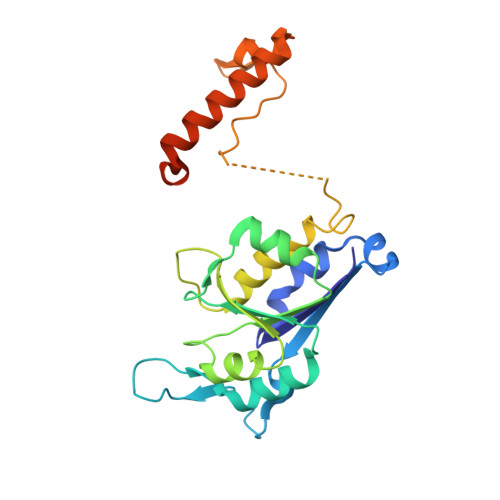Development of Inhibitors againstMycobacterium abscessustRNA (m1G37) Methyltransferase (TrmD) Using Fragment-Based Approaches.
Whitehouse, A.J., Thomas, S.E., Brown, K.P., Fanourakis, A., Chan, D.S., Libardo, M.D.J., Mendes, V., Boshoff, H.I.M., Floto, R.A., Abell, C., Blundell, T.L., Coyne, A.G.(2019) J Med Chem 62: 7210-7232
- PubMed: 31282680
- DOI: https://doi.org/10.1021/acs.jmedchem.9b00809
- Primary Citation of Related Structures:
6QQQ, 6QQR, 6QQT, 6QQU, 6QQV, 6QQW, 6QQZ, 6QR0, 6QR1, 6QR2, 6QR3, 6QR4, 6QR7, 6QR9, 6QRA, 6QRB, 6QRC, 6QRD, 6QRE, 6QRF, 6QRG - PubMed Abstract:
Mycobacterium abscessus ( Mab ) is a rapidly growing species of multidrug-resistant nontuberculous mycobacteria that has emerged as a growing threat to individuals with cystic fibrosis and other pre-existing chronic lung diseases. Mab pulmonary infections are difficult, or sometimes impossible, to treat and result in accelerated lung function decline and premature death. There is therefore an urgent need to develop novel antibiotics with improved efficacy. tRNA (m 1 G37) methyltransferase (TrmD) is a promising target for novel antibiotics. It is essential in Mab and other mycobacteria, improving reading frame maintenance on the ribosome to prevent frameshift errors. In this work, a fragment-based approach was employed with the merging of two fragments bound to the active site, followed by structure-guided elaboration to design potent nanomolar inhibitors against Mab TrmD. Several of these compounds exhibit promising activity against mycobacterial species, including Mycobacterium tuberculosis and Mycobacterium leprae in addition to Mab , supporting the use of TrmD as a target for the development of antimycobacterial compounds.
Organizational Affiliation:
Department of Chemistry , University of Cambridge , Lensfield Road , Cambridge CB2 1EW , U.K.















